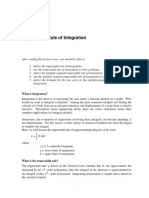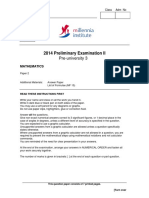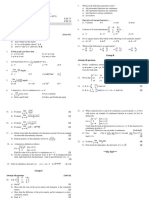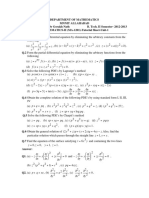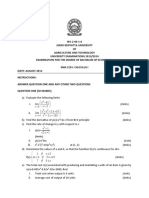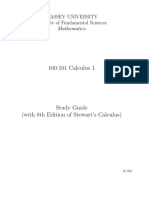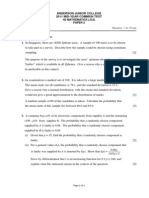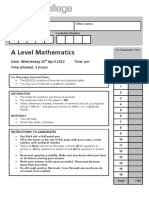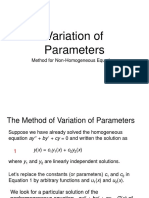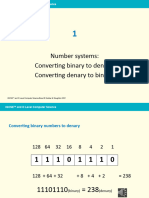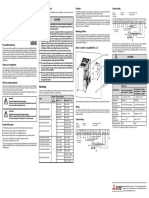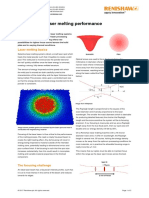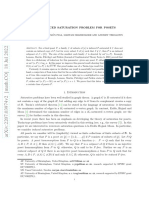OCR FM Statistics Continuous random variables
Topic assessment
1. The continuous random variable X, which takes all values in the interval (-1, 1), has
probability density function
k (1 − x 2 ) −1 x 1
f ( x) =
0 otherwise
where k is a constant.
(i) Show that k = 34 , and sketch the probability density function. [4]
(ii) Find the mean and variance of X. [5]
(iii) Find the probability that an observed value of X will fall in the interval
(-0.1, 0.1). [3]
2. The random variable X has the rectangular distribution on (a, b) so that its probability
density function is given by
1 for a x b,
f ( x) = b − a
0 otherwise.
Show that the mean of X is 12 (a + b) . [2]
Use integration to obtain the variance of X. [5]
3. The continuous random variable X has probability density function f(x) given by
kx 0 x5
f ( x) =
0 otherwise
(i) Show that k = 25 .2
[2]
(ii) Find the median of X. [4]
4. A chemical factory has the capacity to produce up to 1 tonne per day of a particular
chemical. The actual amount produced per day varies and is given by the random variable
X with probability density function
2 x for 0 x 1,
f ( x) =
0 otherwise.
(i) Find the mean and variance of X. [5]
All of the chemical that is produced is sold at a profit of £4000 per tonne, but in addition
there is a fixed overhead charge of £1000 per day. Thus the daily profit from the sales of
this chemical, in thousands of pounds, is Y = 4 X −1 .
(ii) State the mean and variance of Y. [2]
5. An industry regulator is investigating the lengths of times that callers have to wait to be
answered by a telephone enquiry bureau. The waiting times are always between 5 seconds
and 60 seconds.
A model being used for the waiting times, in seconds, is the random variable T with the
1 of 6 26/02/20 © MEI
integralmaths.org
� OCR FM Continuous R.V. Assessment solutions
following cumulative distribution function.
0 t 5
5
F(t ) = k 1 − 5 t 60
t
1 t 60
(i) Show that k = 12
11 . [2]
(ii) Find the median waiting time. [3]
(iii) Find the probability that the length of time a caller waits is no more than twice the
median. [2]
(iv) Derive the probability density function of T. Hence find the mean waiting time. Find
also the probability that a caller waits longer than the mean waiting time. [8]
(v) The bureau takes on extra staff, aiming to halve the waiting times.
The new model for the waiting times is U = 12 T . Find the c.d.f. for U and hence find
the p.d.f. for U. [5]
Total: 52 marks
2 of 6 26/02/20 © MEI
integralmaths.org
� OCR FM Continuous R.V. Assessment solutions
Solutions to topic assessment
1
1. (i) −1
k(1 − x 2 )dx = 1
1
k x − 31 x 3 −1 = 1
k ( 1 − 31 ) − k ( −1 + 31 ) = 1
4
3 k=1
k= 3
4
1 f(x)
x
–1 1
[4]
(ii) By symmetry, E(X) = 0.
1
Var( X ) = x 2 43 (1 − x 2 )dx − [E( X )]2
−1
1
= 3
4 ( x 2 − x 4 )dx − 0
−1
1
= 43 31 x 3 − 51 x 5 −1
= 43 ( 31 − 51 ) − 43 ( − 31 + 51 )
= 1
5
[5]
0.1
(iii) P( −0.1 X 0.1) = 3
4 (1 − x )dx 2
−0.1
0.1
= 43 x − 31 x 3 −0.1
= 43 ( 0.1 − 31 0.001 −( −0.1 − 31 0.001))
= 43 (0.2 − 3000
2
)
= 0.1495
[3]
2.
f(x)
1
b −a
a b
By symmetry, the mean of X is midway between a and b.
So the mean of X is 21 (a + b ) .
[2]
3 of 6 26/02/20 © MEI
integralmaths.org
� OCR FM Continuous R.V. Assessment solutions
b 1
Var(X) = x 2 dx − [E( X )]2
a b −a
1 b
a x dx − 21 (a + b )
2
= 2
b −a
b
1 x 3 (a + b )2
= −
b − a 3 a 4
b 3 − a 3 (a + b )2
= −
3(b − a ) 4
(b − a )(b + ab + a 2 ) a 2 + 2ab + b 2
2
= −
3(b − a ) 4
4b 2 + 4ab + 4a 2 − 3a 2 − 6ab − 3b 2
=
12
= 12 (a − 2ab + b )
1 2 2
= 1
12 (a − b )2
[5]
5
3. (i) 0
kx dx = 1
5
k 21 x 2 0 = 1
1
2 k 25 = 1
k= 2
25
[2]
m
(ii) 0
2
25 x dx = 0.5
m
251 x 2 0 = 0.5
25 m = 0.5
1 2
m 2 = 12.5
m = 3.54 (3 s.f.)
[4]
1
4. (i) E( X ) = x 2 x dx
0
1
= 2 x 2 dx
0
1
= 23 x 3 0
= 23
4 of 6 26/02/20 © MEI
integralmaths.org
� OCR FM Continuous R.V. Assessment solutions
1
Var( X ) = x 2 2 x dx − [E( X )]2
0
1
= 2 x 3 dx − ( 23 )
2
0
1
= 21 x 4 0 − 4
9
= 21 − 49 = 181
[5]
(ii) E(Y ) = 4E( X ) − 1
= 4 23 − 1
= 53
Var(Y ) = 16Var( X )
= 16 181
= 8
9
[2]
5
5. (i) F(60) = 1 k 1 − =1
60
12
11
k=1
k = 12
11
[2]
12 5
(ii) For median waiting time, m, F(m ) = 0.5 1 − = 0.5
11 m
5 11
1− =
m 24
5 13
=
m 24
120
m =
13
[3]
240
(iii) P(T 2m ) = F(2m ) = F
13
12 13
= 1 − 5
11 240
12 35
=
11 48
35
=
44
[2]
5 of 6 26/02/20 © MEI
integralmaths.org
� OCR FM Continuous R.V. Assessment solutions
(iv) f(t ) = F (t )
12 5
=
11 t 2
60
=
11t 2
Probability density function of T is given by
60 5 t 60
f(t ) = 11t 2
0 otherwise
60 60 1
E(T ) =
11 5
t 2 dt
t
60 60 1
11 5 t
= dt
11 ln t 5
= 60 60
= 60
11 (ln 60 − ln 5 )
= 60
11 ln 12
= 13.55 seconds (2 d.p.)
P(T E(T )) = 1 − F( 60
11 ln 12)
12 11
=1− 1 − 5
11 60ln 12
12 1
=1− +
11 ln 12
= 0.312 (3 s.f.)
[8]
(v) P(U u ) = P( 21 T u ) = P(T 2u )
0 2u 5
12
cdf for U is G(u ) = 1 −
5
5 2u 60
11 2u
1 2u 60
0 u 5
2
12
= 1 −
5
5
3 u 30
11 2u
1 u 30
30 u 30
5
pdf for U is f(t ) = 11u 2 2
0 otherwise
6 of 6 26/02/20 © MEI
integralmaths.org





